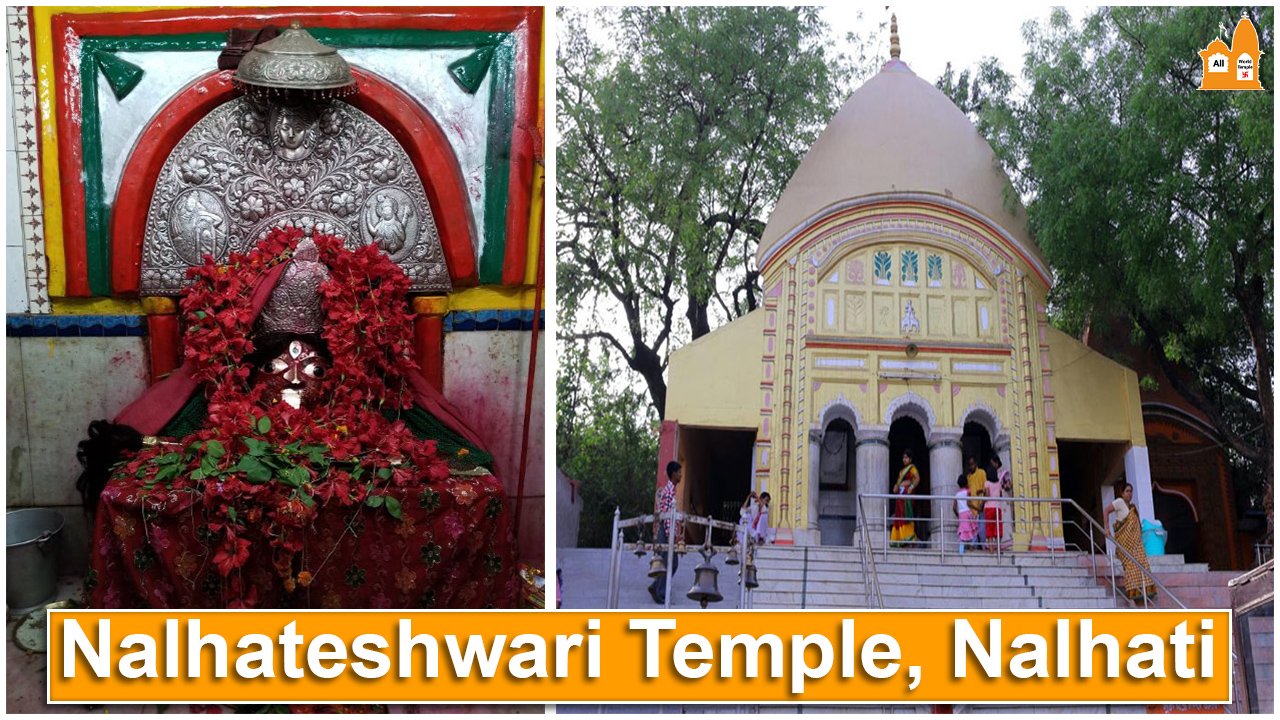Important information
- Location: Nalahati, Temple Road, Nalhati, West Bengal 731243.
- Festivals: Durga Puja For Other Festival Details Click here
- Main Deity: Maa Nalhateshwari For Other Deity Details Click here
- Languages: Bengali & English
- Darshan Timings: 05.30 AM To 08.30 PM
- Best Season To Visit: All
- Photography: Not Allowed
- Contact Number: +919434009435
- How To Reach
The town Nalhati is named after the Nalateshwari temple, among the 51 Sakti Peethas. It is only 16 km from Rampurhat. The town is sanctified by the river Brahmani and Maa Nalateshwari, the Holy Goddess. This temple is believed to have been erected at a spot where the ‘Nala’ the throat of Goddess Sati (Sakti) had fallen. It is also believed that Debi’s ‘Lalat’ (forehead) had fallen there. So she is called ‘Nalateshwari’. The temple is devoted to the Kali form of Goddess Devi.
History
According to the localities, in the 252nd Bengali year or “Bongapto”, “Kamdev” (the Hindu god of love or desire) who had dreamt about its presence, discovered the throat of maa Sati in the Nalahati forest. Another legend depicts that Ram Sharam Devsharma was known to be the very first discoverer of the Nala of Devi Sati and this had marked the beginning of Maa Nalateswri’s devotion.
In the Later half, Bramhachari Kushalnan offered the very first “Bhog” or food offerings. He had begun the salvation on the “Pancha-Munda-Ashana” or the 5-headed Throne. Nalhati is a gorgeous place with peaceful outdoors and plateaus all around. Maa Nalateswri lives in such a soulful place and has Similarities with Kamakha and Kalighat Shakti Peethas. Maa Nalateswri is also praised as Maa or “Bhagobidhata-Nalateswri” or Devi Parvati or Kalika.
The chief legend of Nalhateshwari relates to the creation of the Shakti Peethas. Sati, the daughter of Prajapati Daksha, was married to the god Shiva despite his wishes. Daksha arranged a great yajna but did not invite Sati and Shiva. Uninvited, Sati reached the Yajna site, where Daksha ignored Sati as well as Shiva.
Sati was not able to withstand this insult. So, Devi Sati gave her life by jumping into the fire of Havan organized by her father King Daksh. When Lord Shiva was running around the planet carrying her body Lord Vishnu divided the body into 51 parts utilizing his Sudarshan chakra. Out of those 51 parts, from which the ‘Throat’ of Sati fell to this place.
Importance
People pray to the goddess to fulfill their wishes and remove domestic issues.
Architecture
The attractive temple of Maa Nalateswari looks amazing from the exterior. While you enter inside, you will be surprised at the architecture of the entrance gateway. As you step in the doorway, you will be able to see the “Garb Griha” of the temple directly away, raised over a platform. This leaks the sensation of divinity right from the entrance. Now as you enter into the entrance of the “Garb Griha”, there is an idol of Lord Ganesh, who is surrounded by 8 snakes and is beautified with magnificent colors.
Comes to the main part of the temple. The “Garb Griha” (temple Sanctorum) is crowned with a raised peak where the deity of Maa Nalateswri is worshipped. The sensation of positive energy (that assists in damaging the evils of life) increases within as you look at the deity of Maa. The deity has big eyes, also called “Trinayan” (or 3 eyed deities), a red-colored tongue made from gold whereas the face is entirely laden with sindoor or vermilion (the sign of the marital relationship of Hindu females) which is much more adorned with thick eyebrows, teeth, nose, and a tiny forehead. Listed below the golden tongue there lies the “Nala” or throat of Devi Sati. No matter how much water is being poured down the throat, it will never ever get overflowed or dried up even in the lack of it for numerous days. When the water moves down the throat there is a noise produced which can be acknowledged as a gulp echo, even.
Idol
- The stone idol of 4 feet height has three eyes (trinetra) and a huge golden tongue hanging in between the teeth. The larynx or the “Nala” of the Idol is positioned where the tongue ends. She drinks water creating the sound of the gulping.
Festivals
- October – Dusshera, Navratri
- November – Kali Puja
How to Reach
- By Air: The nearby Airport to Maa Nalateswari Temple is Rajshahi Airport and it is 70 km away from Maa Nalateswari Temple.
- By Train: Nalhati is the nearby Railway Station and it is located at the junction of Azimganj, a connector of Howrah-Sahibgunge, eastern railway loop.
- By Road: You can reach the Temple by train followed by bus or any other transport.
Temple Timings
Darshan Timing
| 05.30 AM To 08.30 PM |
